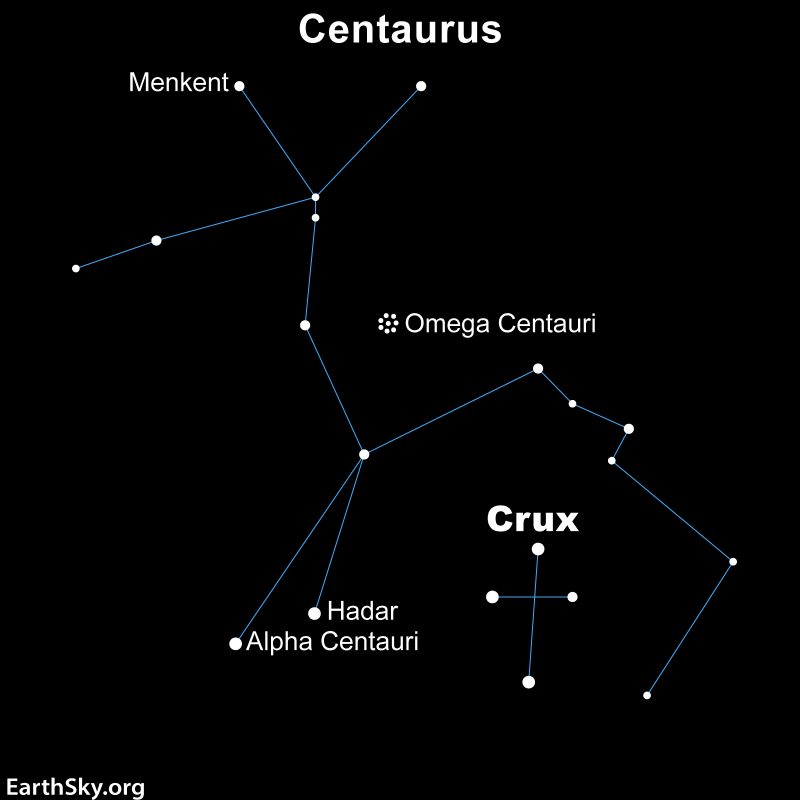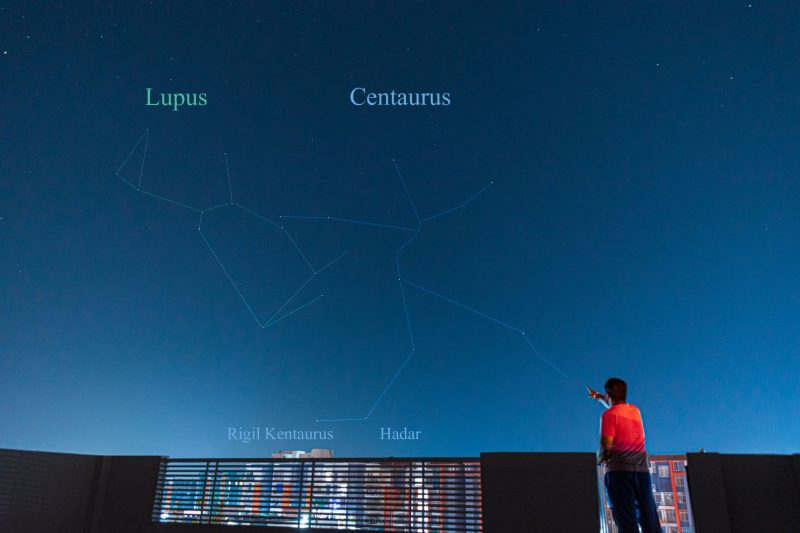
Centaurus the Centaur is a constellation lying in Southern Hemisphere skies. The constellation is huge, ranking 9th largest of the 88 constellations. It sits so far south that if you live about 25 degrees north latitude, you won’t be able to see it. The Centaur contains the three closest known stars to the sun.
Closest stars to the sun
Alpha Centauri, also known as Rigil Kentaurus, is the closest star to our sun. It lies 4.3 light-years away. Because it’s so close, it appears bright. In fact, it’s the 3rd brightest star in the sky, shining at magnitude -0.27.
Alpha Centauri is a three-star system. Alpha Centauri A and B are both sunlike stars, with A outshining B. The third star, however, is a faint red dwarf. This star, Alpha Centauri C, is also known as Proxima Centauri. That’s because out of the three stars in the system, it’s the closest to Earth. By itself, it shines at 11th magnitude.
Other stars of Centaurus the Centaur
Only 4.5 degrees from Alpha Centauri is Beta Centauri, also known as Hadar.
Beta Centauri is magnitude 0.61 and lies 348 light-years away. This blue-white supergiant is the 11th brightest star in the sky. Indeed, when compared to its bright neighbor Alpha, looks distinctly bluer. In addition, it’s also a three-star system.
Alpha and Beta also bear the nickname of the Southern Pointer stars because they can guide you to the Southern Cross, or Crux, and the south celestial pole.
Likewise, one other notable named star in Centaurus is Menkent, or Theta Centauri. It lies 24 degrees north of Alpha and Beta. Theta is magnitude 2.06 and lies 61 light-years away.

Omega Centauri, the Running Chicken and a Blue Planetary
The best-known deep-sky object in the constellation of the Centaur is Omega Centauri (NGC 5139). Omega Centauri is a magnificent globular cluster that lies about halfway between Beta and Theta Centauri and a few degrees west. In fact, at magnitude 3.7, you can spot the cluster without optical aid. But binoculars or a small telescope bring out its wonders. This crowded cluster is an old collection of stars in our galaxy about 15,800 light-years away. The globular cluster is about 12 billion years old.
Similarly, the Running Chicken is a quirkily nicknamed cluster and gas cloud for IC 2944 in Centaurus. It lies on the other side of Crux from Alpha and Beta Centauri, where Centaurus wraps around the Southern Cross. At the southern tip of Centaurus, this star cluster with nebulosity shines at magnitude 4. The star Lambda Centauri is here, along with dark clouds that stick out in front of the background nebulosity. These dark clouds are known as Bok globules.
The last-deep sky target is NGC 3918, known as the Blue Planetary. This planetary nebula shines at magnitude 8 and lies about 6 degrees north of the Running Chicken. It bears a resemblance to Neptune through a telescope.

Bottom line: Centaurus the Centaur is a constellation found in Southern Hemisphere skies that contains some of the closest stars to our sun.











